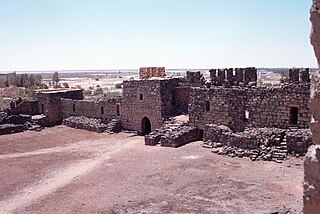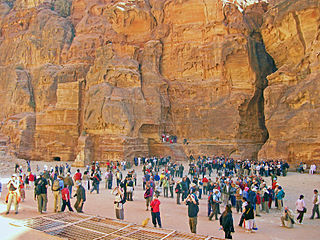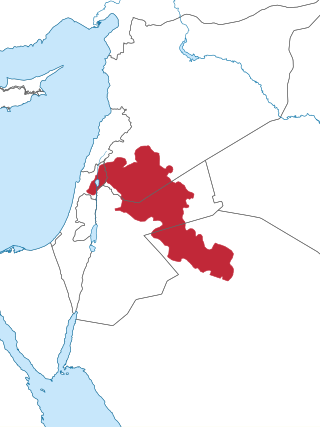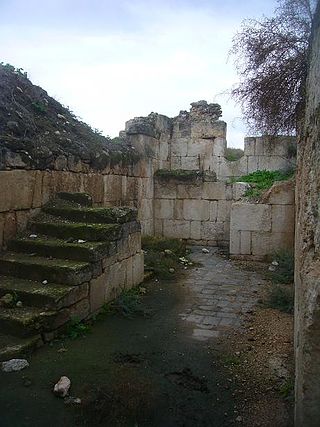
Qusayr 'Amra or Quseir Amra, lit. "small qasr of 'Amra", sometimes also named Qasr Amra, is the best-known of the desert castles located in present-day eastern Jordan. It was built some time between 723 and 743, by Walid Ibn Yazid, the future Umayyad caliph Walid II, whose dominance of the region was rising at the time. It is considered one of the most important examples of early Islamic art and architecture.

Zarqa Governorate is the third largest governorate in Jordan by population. The capital of Zarqa governorate is Zarqa City, which is the largest city in the governorate. It is located 25 kilometres (16 mi) east of the Jordanian capital Amman. The second largest city in the governorate is Russeifa.

Hisham's Palace, also known as Khirbat al-Mafjar, is an important early Islamic archaeological site in the Palestinian city of Jericho, in the West Bank. Built by the Umayyad dynasty in the first half of the 8th century, it is one of the so-called Umayyad desert castles. It is located 3 km north of Jericho's city center, in an area governed by the Palestinian National Authority (PNA).

Qasr al-Azraq is a large fortress located in present-day eastern Jordan. It is one of the desert castles, located on the outskirts of present-day Azraq, roughly 100 km (62 mi) east of Amman.

Azraq is a small town in Zarqa Governorate in central-eastern Jordan, 100 kilometres (62 mi) east of Amman. The population of Azraq was 9,021 in 2004. The Muwaffaq Salti Air Base is located in Azraq.

Jordan is a sovereign Arab state in the Middle East. The capital, Amman, is Jordan's most populous city as well as the country's economic, political and cultural centre.

The Ḥarrat al-Shām, also known as the Black Desert, is a region of rocky, basaltic desert straddling southern Syria and the northern Arabian Peninsula. It covers an area of some 40,000 km2 (15,000 sq mi) in the modern-day Syrian Arab Republic, Jordan, Israel and Saudi Arabia. Vegetation is characteristically open acacia shrubland with patches of juniper at higher altitudes.

The desert castles or qasrs are often called Umayyad desert castles, since the vast majority of these fortified palaces or castles were built by the Umayyad Dynasty in their province of Bilad ash-Sham, with very few Abbasid exceptions. The desert castles of Jordan represent a prominent part of this group of buildings, with most Umayyad "desert castles" being scattered over the semi-arid regions of north-eastern Jordan, with several more in Syria, Israel and the West Bank (Palestine), and just one Abbasid exception in Iraq.

Jordanian art has a very ancient history. Some of the earliest figurines, found at Aïn Ghazal, near Amman, have been dated to the Neolithic period. A distinct Jordanian aesthetic in art and architecture emerged as part of a broader Islamic art tradition which flourished from the 7th-century. Traditional art and craft is vested in material culture including mosaics, ceramics, weaving, silver work, music, glass-blowing and calligraphy. The rise of colonialism in North Africa and the Middle East, led to a dilution of traditional aesthetics. In the early 20th-century, following the creation of the independent nation of Jordan, a contemporary Jordanian art movement emerged and began to search for a distinctly Jordanian art aesthetic that combined both tradition and contemporary art forms.

Qasr al-Hayr al-Gharbi is a Syrian desert castle or qasr located 80 km south-west of Palmyra on the Damascus road. The castle is a twin palace of Qasr al-Hayr al-Sharqi, built by the Umayyad caliph Hisham ibn Abd al-Malik in 727 CE. It was built in the Umayyad architectural style. As the complex was believed to be an estate owned by someone of wealth, it is no surprise that some decorations for it's opulent owners may be found within the remains of the palace. Many decorations and artwork from the complex are kept at the National Museum in Damascus. Some items found within include richly decorated floor frescoes, stucco walls, and figural reliefs.

Al-Muwaqqar is a district in the Amman Governorate of north-western Jordan. The village contains the scant ruins of an Umayyad palace, the Qasr al-Muwaqqar, one of the desert castles. Little remains of the palace today except several acanthus leaf capitals and gauge of a water reservoir.

Qasr al-Hallabat is an Umayyad desert castle, with the associated bath house of Hammam as-Sarah east of it. The nearby modern town, named after the castle, is part of the Zarqa Governorate of north-western Jordan, north-east of the capital of Amman.

There are at least seven nature reserves in Jordan. In 1966, the organization that would later start Jordan's nature reserves, the Royal Society for the Conservation of Nature, was founded. RSCN's first efforts involved bringing back severely endangered species. In 1973, RSCN, was given the right to issue hunting licenses, giving RSCN an upper hand in preventing extinction. The first step was the founding of Jordan's first nature reserve, Shaumari Wildlife Reserve, in 1975. The primary purpose was to create means to breed endangered species, specifically: the Arabian oryx, gazelles, ostriches and Persian onagers in their natural environment.

Khirbat al-Minya, also known as Ayn Minyat Hisham (Arabic) or Horvat Minnim (Hebrew) is an Umayyad-built palace in the eastern Galilee, Israel, located about 200 meters (660 ft) west of the northern end of Lake Tiberias. It was erected as a qasr complex, with a palace, mosque, and bath built by a single patron.

Hammam al-Sarah is an Umayyad bathhouse (hammam) in Jordan, built in connection with the complex of Qasr al-Hallabat, which stands some 2 kilometres (1.2 mi) to the west. Along with examples in the other desert castles of Jordan, it is one of the oldest surviving remains of a Muslim bathhouse.
Qasr Tuba is an 8th-century Umayyad qasr or castle in the Amman Governorate of northern Jordan.
Alison Venetia Graham Betts is a Scottish archaeologist and academic, who specialises in the "archaeology of the lands along the Silk Roads" and the nomadic peoples of the Near East. Since 2012, she has been Professor of Silk Road Studies at the University of Sydney.

Wadi Feynan or Wadi Faynan is a major wadi and region in southern Jordan, on the border between Tafilah Governorate and Aqaba and Ma'an Governorates. It originates in the southern Jordanian Highlands with the confluence of Wadi Dana and Wadi Ghuweyr, and drains into the Dead Sea via Wadi Araba.

Dhuweila is an archaeological site in the Badia of eastern Jordan. It contains the remains of a small hunting camp, which was first built and occupied in the Early Neolithic and reoccupied, after a hiatus, in the Late Neolithic. The Early Neolithic occupation dates to between 7360 and 7080 BCE.





















